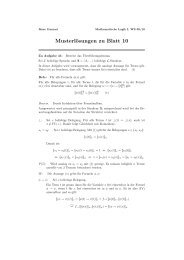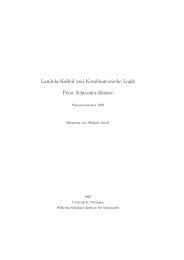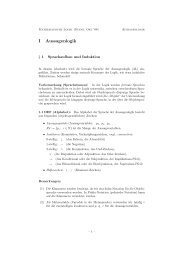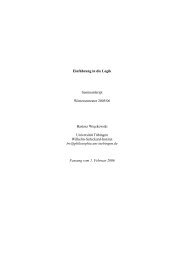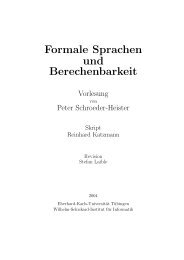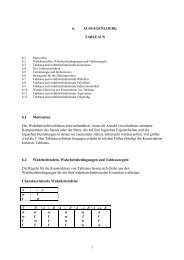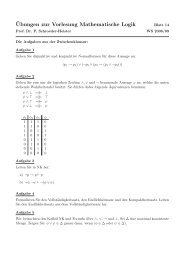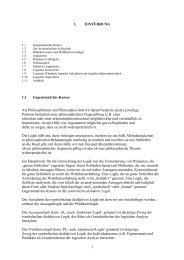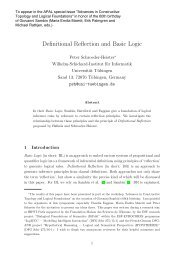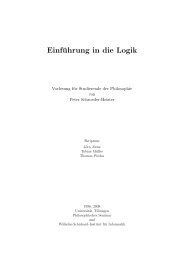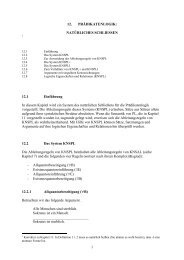Constructive semantics and the validity of Peirce's law
Constructive semantics and the validity of Peirce's law
Constructive semantics and the validity of Peirce's law
Create successful ePaper yourself
Turn your PDF publications into a flip-book with our unique Google optimized e-Paper software.
Theorem 2 (Classical logic). If ϕ is a classical consequence <strong>of</strong> Γ, <strong>the</strong>n<br />
Γ �B ϕ.<br />
This justification is built upon monotonic extensions <strong>of</strong> bases, that is, if B ′ ⊇ B, <strong>the</strong>n<br />
�B ϕ ⇒ �B ′ ϕ. What S<strong>and</strong>qvist would <strong>the</strong>refore have achieved is a justification <strong>of</strong><br />
classical logic in <strong>the</strong> context delineated. 4 He says (ibid., p. 214):<br />
Thus, whatever your attitude towards particular inferences among atoms,<br />
in so far as your use <strong>of</strong> logical compounds is governed by <strong>the</strong> <strong>semantics</strong><br />
we have formulated, you have no choice but to accept all classically valid<br />
sentences <strong>and</strong> inferences.<br />
Remark on intuitionistic versus classical disjunction<br />
It should be emphasized that S<strong>and</strong>qvist’s Theorem 2 applies without restriction only<br />
to <strong>the</strong> fragment <strong>of</strong> classical logic he is considering, that is, <strong>the</strong> fragment based on<br />
{⊃, ⊥, ∀}. If we include disjunction (or analogously existential quantification), <strong>the</strong>n<br />
<strong>the</strong> <strong>validity</strong> <strong>of</strong> double negation elimination can no longer be reduced to <strong>the</strong> atomic<br />
case, provided disjunction is given its intuitionistic interpretation according to <strong>the</strong><br />
following semantical rule:<br />
�B ϕ ∨ � ⇐⇒ �B ϕ or �B � (5)<br />
In particular, Lemma 4 does not necessarily hold, if ϕ has <strong>the</strong> form � ∨ ¬�. Thus<br />
S<strong>and</strong>qvist has not given an example <strong>of</strong> a valid <strong>law</strong> which is not derivable in intuitionistic<br />
logic, if disjunction is understood intuitionistically, since <strong>of</strong> a valid <strong>law</strong> we would<br />
expect that its substitution instances, including those containing disjunction, are valid<br />
as well. Of course, if we underst<strong>and</strong> disjunction ϕ ∨� not in its intuitionistic sense (5)<br />
but in its classical sense by its de Morgan equivalent ¬(¬ϕ ∧ ¬�), <strong>the</strong>n Lemma 4<br />
provides such an example. S<strong>and</strong>qvist is fully aware <strong>of</strong> this fact <strong>and</strong> mentions this<br />
point explicitly (ibid., p. 215).<br />
This restriction concerning intuitionistic disjunction affects <strong>the</strong> significance <strong>of</strong><br />
S<strong>and</strong>qvist’s result only marginally. The fact that S<strong>and</strong>qvist’s <strong>semantics</strong> validates<br />
<strong>the</strong> <strong>law</strong>s <strong>of</strong> classical logic for intuitionistically understood implication is a crucial<br />
point which is against basic intuitions <strong>of</strong> intuitionism, in particular, as he does not<br />
presuppose that atomic formulas behave classically, but instead proves that this is<br />
<strong>the</strong> case. Taking this into account we can interpret S<strong>and</strong>qvist’s result as follows: If<br />
disjunction is understood classically, <strong>the</strong>n <strong>the</strong> intuitionistic <strong>semantics</strong> proposed in<br />
his Definition 1 renders all classical <strong>law</strong>s valid. This is definitely not something an<br />
intuitionist would accept <strong>and</strong> a very remarkable conceptual result. It can be viewed<br />
ei<strong>the</strong>r as a constructive justification <strong>of</strong> classical logic (this is how S<strong>and</strong>qvist reads it),<br />
or as pointing to certain deficiencies <strong>of</strong> <strong>the</strong> underlying <strong>semantics</strong> (as we read it).<br />
3 Admissibility versus derivability<br />
We want to point out that S<strong>and</strong>qvist’s <strong>semantics</strong> is inadequate. It relies on a too narrow<br />
notion <strong>of</strong> what is a basic rule, since <strong>the</strong> discharging <strong>of</strong> assumptions is excluded. That<br />
4 This context is quite similar to constructivist approaches.<br />
4



